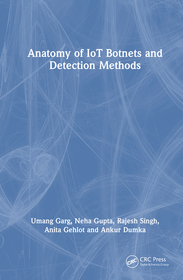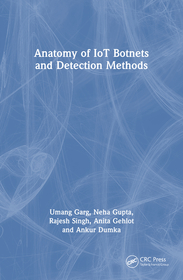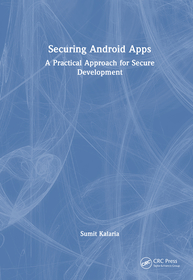
Anatomy of IoT Botnets and Detection Methods
-
10% KEDVEZMÉNY?
- A kedvezmény csak az 'Értesítés a kedvenc témákról' hírlevelünk címzettjeinek rendeléseire érvényes.
- Kiadói listaár GBP 110.00
-
52 552 Ft (50 050 Ft + 5% áfa)
Az ár azért becsült, mert a rendelés pillanatában nem lehet pontosan tudni, hogy a beérkezéskor milyen lesz a forint árfolyama az adott termék eredeti devizájához képest. Ha a forint romlana, kissé többet, ha javulna, kissé kevesebbet kell majd fizetnie.
- Kedvezmény(ek) 10% (cc. 5 255 Ft off)
- Kedvezményes ár 47 297 Ft (45 045 Ft + 5% áfa)
Iratkozzon fel most és részesüljön kedvezőbb árainkból!
Feliratkozom
52 552 Ft

Beszerezhetőség
Még nem jelent meg, de rendelhető. A megjelenéstől számított néhány héten belül megérkezik.
Why don't you give exact delivery time?
A beszerzés időigényét az eddigi tapasztalatokra alapozva adjuk meg. Azért becsült, mert a terméket külföldről hozzuk be, így a kiadó kiszolgálásának pillanatnyi gyorsaságától is függ. A megadottnál gyorsabb és lassabb szállítás is elképzelhető, de mindent megteszünk, hogy Ön a lehető leghamarabb jusson hozzá a termékhez.
A termék adatai:
- Kiadás sorszáma 1
- Kiadó CRC Press
- Megjelenés dátuma 2025. november 12.
- ISBN 9781041050223
- Kötéstípus Keménykötés
- Terjedelem230 oldal
- Méret 234x156 mm
- Nyelv angol
- Illusztrációk 11 Illustrations, black & white; 2 Halftones, black & white; 9 Line drawings, black & white; 6 Tables, black & white 700
Kategóriák
Rövid leírás:
The book Anatomy of IoT Botnets and Detection Methods delves into the evolving landscape of cybersecurity threats associated with the Internet of Things (IoT), specifically focusing on the anatomy, behavior, and detection of IoT-based botnets.
TöbbHosszú leírás:
The book Anatomy of IoT Botnets and Detection Methods delves into the evolving landscape of cybersecurity threats associated with the Internet of Things (IoT), specifically focusing on the anatomy, behavior, and detection of IoT-based botnets. As IoT devices proliferate in both consumer and industrial settings, their inherent vulnerabilities—such as weak authentication, limited processing power, and lack of regular updates—make them prime targets for attackers. The book begins by exploring how IoT botnets are formed, highlighting key attack vectors such as malware propagation, command, and control (C&C) mechanisms, and commonly exploited protocols such as Telnet and UPnP. Notable case studies, including the Mirai and Mozi botnets, illustrate real-world impacts, emphasizing the scale and damage these threats can inflict. The core of the book then transitions into detection methodologies, covering both traditional and AI-driven approaches. Techniques such as signature-based detection, anomaly detection using machine learning, network traffic analysis, and honeypot deployment are thoroughly examined. The authors also address the challenges in detecting IoT botnets, including encrypted traffic, device heterogeneity, and low visibility in resource-constrained devices. Furthermore, the book emphasizes the importance of proactive defense strategies, such as firmware hardening, secure boot mechanisms, and real-time behavioral analytics. It underscores the role of collaborative intelligence sharing among stakeholders to enhance detection capabilities. By integrating theoretical concepts with practical insights and current research trends, the book provides a comprehensive guide for researchers, cybersecurity professionals, and IoT developers aiming to understand and counteract botnet threats. Ultimately, Anatomy of IoT Botnet and Detection Methods serves as a crucial resource for strengthening the cybersecurity posture of IoT ecosystems through informed detection and mitigation practices. The content of the book is categorized into the following sub-sections:
- Introduction to IoT and Botnets: An overview of IoT technology, its adoption, and the rising threat of botnets.
- IoT Device Vulnerabilities: Analysis of common security weaknesses in IoT devices that cybercriminals exploit.
- Botnet Architecture: Detailed examination of how IoT botnets are structured, including command-and-control mechanisms.
- Infection and Propagation: Methods used by attackers to spread malware across IoT networks.
- Detection Techniques: Overview of current detection methods, including anomaly detection, signature-based approaches, and machine learning.
- Mitigation Strategies: Practical advice on how to secure IoT devices, including best practices for manufacturers and users.
- Case Studies: Real-world examples of IoT botnet attacks and their impact.
The book concludes with a discussion on the future of IoT security, emphasizing the need for continuous innovation in detection and prevention methods.
TöbbTartalomjegyzék:
Chapter 1: Introduction
•1.1 Overview of the Internet of Things (IoT)
•1.2 Challenges in IoT
•1.3 Security issues in IoT
•1.4 Rise of IoT Botnets
•1.5 Objectives and Scope of the IoT botnet
•1.6 Conclusion
Chapter 2: IoT Device Vulnerabilities
•2.1 IoT Architecture, protocol, and Techology
•2.2 Common Security Weaknesses in IoT Devices
•2.2 Firmware and Software Vulnerabilities
•2.3 Inadequate Authentication and Authorization
•2.4 Insufficient Data Protection and Privacy
•2.5 The Role of Manufacturers in IoT Security
•2.6 Conclusion
Chapter 3: Understanding IoT Botnets
•3.1 Anatomy of a Botnet
•3.2 Types of Botnets: From PC-Based to IoT Botnets
•3.3 Common Botnet Attacks: DDoS, Spam, and Data Theft
•3.4 Command-and-Control (C&C) Infrastructure
•3.5 Infection Vectors and Propagation Techniques
•3.6 Persistence and Evasion Tactics
•3.7 Conclusion
Chapter 4: Real-World IoT Botnet Case Studies
•4.1 The Mirai Botnet
•4.2 The Hajime Botnet
•4.3 The Reaper Botnet
•4.4 Analysis of Recent IoT Botnet Attacks
•4.5 Research findings from Case Studies
Chapter 5: Detection Techniques for IoT Botnets
•5.1 Signature-Based Detection
•5.2 Anomaly-Based Detection
•5.3 Behavior Analysis
•5.4 Machine Learning and AI Approaches
•5.5 Network Traffic Analysis and Behavioral Monitoring
•5.6 Challenges in Detecting IoT Botnets
Chapter 6: Mitigation and Prevention Strategies
•6.1 Best Practices for Securing IoT Devices
•6.2 Firmware Updates and Patch Management
•6.3 Strong Authentication and Encryption Mechanisms
•6.4 Network Segmentation and Isolation
•6.5 Incident Response and Recovery Strategies
Chapter 7: The Role of IoT Manufacturers and Developers
•7.1 Secure Software Development Life Cycle (SDLC) for IoT
•7.2 Implementing Security by Design
•7.3 The Importance of User Education and Awareness
•7.4 Industry Standards and Certifications
Chapter 8: Global Perspectives on IoT Security
•8.1 International Standards and Frameworks
•8.2 The Role of Governments and Regulatory Bodies
•8.3 Collaborative Efforts in Combatting IoT Botnets
•8.4 The Future of Global IoT Security
Chapter 9: Future Trends in IoT Botnets and Security
•9.1 Emerging Threats in IoT Ecosystems
•9.2 The Role of AI and Machine Learning in Future Botnets
•9.3 Predicting and Preparing for the Next Wave of Attacks
•9.4 Innovations in Detection and Prevention Technologies
Conclusion
•Summary
•The Importance of a Proactive Approach to IoT Security
•Final Thoughts on the Evolving IoT Threat Landscape












